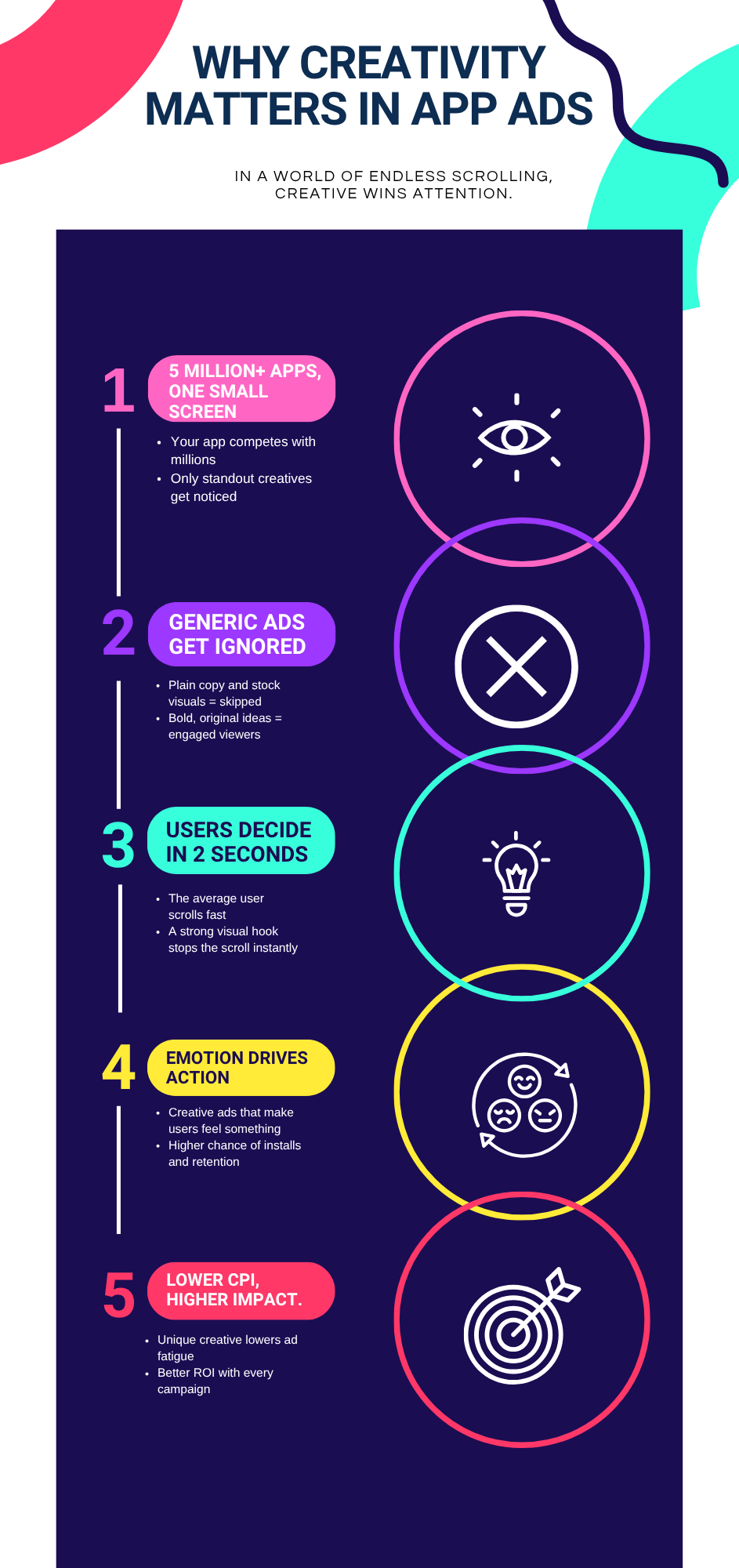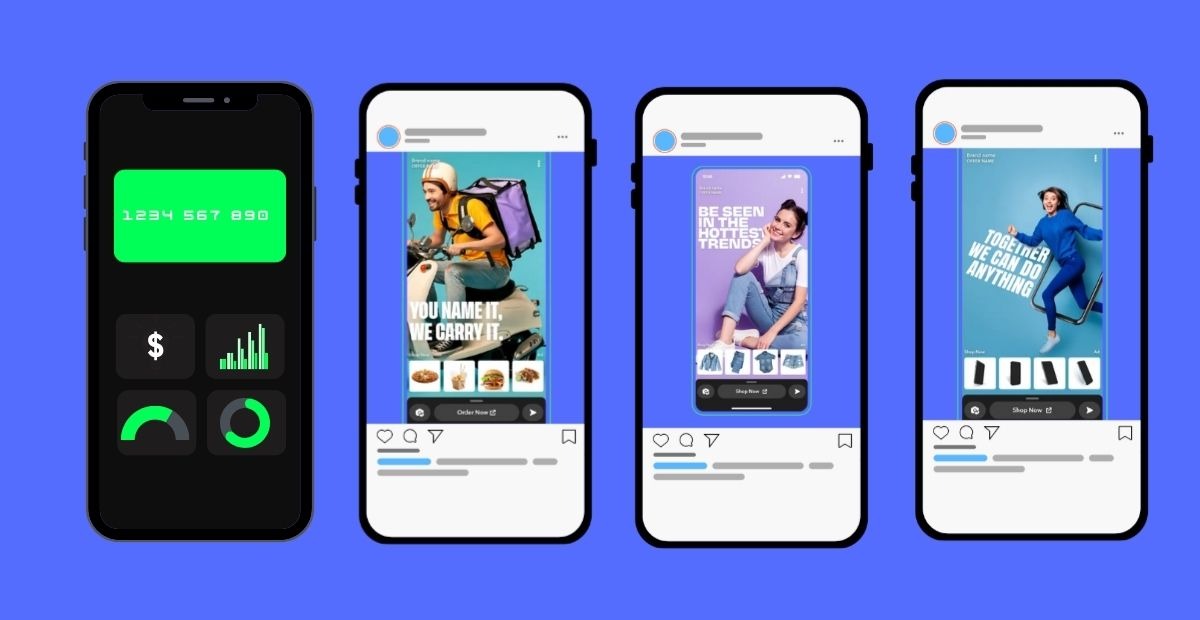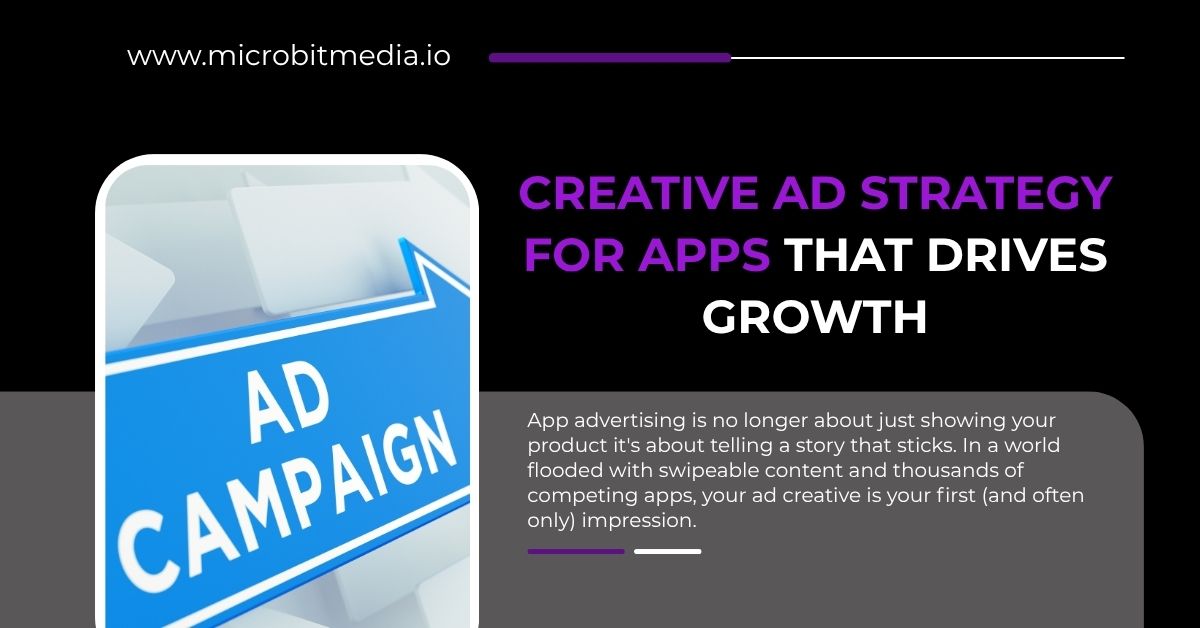App advertising is no longer about just showing your product it’s about telling a story that sticks. In a world flooded with swipeable content and thousands of competing apps, your ad creative is your first (and often only) impression.
A great creative ad strategy for apps blends smart visuals, emotional appeal, platform-specific formats, and performance-driven thinking. It’s not about being flashy, it’s about being relevant, relatable, and results-focused.
Whether you are launching a meditation app, a game, or a fintech tool, the right creative can turn a scroll into an install. From short-form video ads on TikTok to playable previews on Meta, it’s all about crafting moments that matter and convert.
Let’s explore how you can build a winning creative strategy that actually drives downloads, engagement, and retention.
Why Creativity Is Key in App Advertising?
Creative ad execution is what separates a forgettable scroll from a high-converting click. In today’s saturated app ecosystem, simply showcasing features is not enough. You need to connect with your audience emotionally and creativity is your sharpest tool.
People interact with dozens of ads daily, but they only remember the ones that feel different. A bold visual, a clever message, or a relatable scenario can instantly grab attention and build interest. For example, Duolingo’s quirky TikTok ads didn’t just showcase a language app, they turned the mascot into a meme-worthy brand icon, leading to massive organic reach.

More importantly, creative advertising reduces ad fatigue. By constantly refreshing visuals and experimenting with new formats like interactive playables or short-form vertical videos, brands can keep their message fresh and users engaged.
In the world of mobile app marketing, creativity is not a luxury, it is the competitive edge that drives installs, boosts retention, and turns users into advocates.
Breaking Through the Noise
With millions of apps competing for attention, standing out is harder than ever. A creative mobile app advertising strategy helps your brand cut through the digital clutter and get noticed.
With millions of apps competing for attention, standing out is harder than ever. A creative mobile app advertising strategy helps your brand cut through the digital clutter and get noticed.
Take Canva’s app ads, for example. They use clean, colorful visuals with simple, benefit-focused text. It is not about shouting louder, it is about showing up differently.
In a crowded feed, being unique is your best strategy. Creativity is what makes your ad not just seen but remembered.
Emotional Engagement Drives Installs
People do not download apps just for features, they download them for how those features make them feel. That is why emotional engagement is a core part of any successful app advertising strategy.
Ads that trigger emotions like joy, curiosity, or even nostalgia create a stronger memory link. When users feel something, they are far more likely to take action. Think about Headspace’s calm, soothing visuals or Bumble’s confident, empowering messages both use emotion to spark connection and drive installs.
You do not need a blockbuster budget to create emotional ads. Even a simple story or user pain point delivered through relatable language and visuals can build a bond that leads to more downloads. In short, emotion fuels action.
Differentiation in a Crowded App Store
With over 3 million apps on Google Play and the App Store, blending in is a recipe for failure. A strong creative ad strategy for mobile apps helps your brand stand out before users even land on your app listing.
Your ad is often the first interaction a potential user has with your app. If it looks and sounds like every other ad, you will be ignored. But if it showcases a unique value or tells a fresh story, you create instant differentiation.
For example, the language-learning app Memrise uses real people and street interviews in its video ads, setting it apart from polished, studio-shot competitors. That raw, authentic style makes it memorable.
In crowded markets, your creative approach is your identity. It is how you say, “we’re not like the rest” and that is exactly what gets users to click.
Elements of a High-Impact Creative Ad Strategy
A high-performing and creative strategy for mobile apps is never random. It blends visual storytelling, platform alignment, and psychological triggers to drive user action. Every great campaign shares a few core elements and they go far beyond just nice graphics.
First, the best creatives are designed with mobile-first thinking. This means short formats, vertical layouts, fast pacing, and instant hooks. Your ad needs to catch attention in less than three seconds or it is gone.
Second, successful strategies adapt to the platform’s strengths. What works on TikTok may fail on Meta or YouTube. Knowing the creative nuances of each platform gives your ad the best chance to convert.
Lastly, emotion and intent must align. Whether you are using humor, urgency, or storytelling, each creative element must connect with the user’s mindset. That is how you turn curiosity into conversions and viewers into users.
Visual Storytelling for Mobile Screens
Mobile users scroll fast. To catch their eye, your ad must tell a story visually and instantly. That is where visual storytelling becomes a powerful piece of your creative ad strategy for apps.
Instead of cramming text or overexplaining features, show the experience. Use clear visuals, motion, and emotion to guide users through a journey even in a 15-second clip. Think of apps like Calm or Pinterest; their ads often rely on serene imagery, smooth transitions, and minimal words to convey a feeling.
It is also important to design for vertical formats, where thumbs rule. Use large fonts, clean layouts, and focus on one key message per frame. Visuals should do the heavy lifting, especially when autoplay is muted.
Great visual storytelling does not just inform it. And that is exactly what mobile users respond to.
Platform-Specific Adaptations (Meta, Google UAC, TikTok)
Each ad platform plays by different rules and your app ad creative strategy should reflect that. One-size-fits-all creatives rarely deliver strong results across Meta, Google UAC, and TikTok.
On Meta (Facebook & Instagram), users scroll quickly. You need bold visuals, snappy captions, and thumb-stopping intros. Use native UI elements like Stories polls or Reels transitions to blend in while still standing out.
Google UAC relies heavily on machine learning. It auto-generates combinations of your assets, so your creative set must include a balanced mix of videos, images, and text. High-performing assets are clean, clear, and aligned with user intent especially during high-intent search queries.
TikTok thrives on authenticity. Overly polished videos fall flat. Instead, lean into trends, humor, and raw storytelling. Ads that mimic organic content often outperform traditional spots. For example, Duolingo’s native-style skits drove massive engagement because they felt like real TikToks.
Adapt your creative style to match the platform and your chances of user acquisition skyrocket.
Using Psychology in Ad Design
Great mobile ad creatives do more than look good; they tap into how people think, feel, and decide. Using psychology in ad design for apps helps influence user behavior and boost conversions.
Simple psychological triggers like urgency (“Limited-time offer”), social proof (“Join 10M+ users”), and loss aversion (“Don’t miss out”) can dramatically improve click-through rates. These cues speak directly to the brain’s decision-making shortcuts.
Color also plays a big role. For example, red can create excitement, while blue builds trust which is why many finance and health apps lean toward blue palettes.
By understanding how users think, brands can design app ads that feel more relevant, trustworthy, and persuasive leading to more downloads and higher ROI.
Winning Formats for App Ad Creatives
The format of your ad can make or break its performance. In mobile app marketing, using the right creative ad formats is just as important as the message itself. Users respond differently depending on how content is delivered and great strategies play to that strength.
Short-form vertical videos dominate platforms like TikTok, Instagram Reels, and YouTube Shorts. These bite-sized visuals are fast, fun, and scroll-stopping perfect for showcasing app features, benefits, or even real user reactions in under 30 seconds.

Another high-impact format is interactive playables. These ads let users try a mini version of your app before installing. Especially effective for games and utility tools, playables reduce friction and boost install intent.
Then there’s user-generated content (UGC) raw, authentic, and incredibly persuasive. Whether it’s an influencer demo or a casual selfie review, UGC builds trust and feels more relatable than polished branded ads.
By experimenting with these proven formats, you can find what resonates best and turn more impressions into engaged users.
Short-form Video Ads
Short-form video ads have become the go-to format for mobile app advertising and for good reason. They grab attention fast, deliver a clear message, and fit perfectly within today’s scroll-heavy habits.
These videos, usually under 30 seconds, are designed to tell a quick, impactful story. Whether it’s a fast demo of your app, a snappy tutorial, or a fun user reaction the goal is to hook the viewer in the first few seconds.
Apps like TikTok, Instagram Reels, and YouTube Shorts thrive on this format. For example, food delivery apps often show a quick craving-to-doorstep journey, triggering instant desire and installs. Fitness apps may show before-after moments, tapping into transformation emotions.
The key is to keep it vertical, visually engaging, and benefit-focused. Short-form ads are not about cramming features, they are about showing why your app matters in a moment that sticks.
Interactive Playables and Gamified Ads
Interactive playable ads are changing the game for app marketers especially in the gaming and utility space. These ad formats let users try a mini-version of your app before they commit to installing it, creating a hands-on experience that builds trust and excitement.
When users engage with a playable ad, they are not just watching what they are experiencing. This leads to higher engagement rates and stronger intent, because the user knows what they are getting. It reduces the gap between curiosity and conversion.
Take games like Candy Crush or Ebony. They’ve used playable ads that simulate the first level, letting users tap, swipe, or solve puzzles right inside the ad. This creative not only boosts click-through rates but also improves install-to-retention ratios.
For non-gaming apps, gamified ad elements like rewards, quizzes, or interactive demos can also drive action. The key is simple: let users feel your app before they install it.
User-Generated Content & Social Proof
In app marketing, user-generated content (UGC) is one of the most powerful tools for building trust. When real users share their experiences, it feels authentic, and that authenticity drives conversions.
People trust people more than polished brand ads. That is why platforms like TikTok and Instagram have become goldmines for UGC, whether it is a screen recording of someone using your app or a testimonial about how it changed their routine. This kind of content builds social proof, a key element in any high-impact creative app ad strategy.
Consider how fitness or budgeting apps showcase real progress stories or user milestones. These moments feel relatable, inspire action, and often outperform traditional ad formats. UGC not only adds credibility, but it also scales easily and connects with audiences on a deeper level.
Testing and Iterating Creative Performance
A strong creative advertising strategy for apps does not end at launch; it evolves through continuous testing. What grabs attention today might fall flat tomorrow. That is why data-backed iteration is the secret weapon behind sustained performance.
Start with A/B testing different ad creatives. Change one element at a time: the headline, the image, the CTA, and track what drives better installs or engagement. Even small tweaks can impact performance.
Then, look beyond surface-level metrics. Do not just track impressions or clicks. Focus on install rates, session lengths, and in-app actions tied to each creative. That helps you understand not just what attracts users, but what retains them.
The best-performing app brands do not rely on gut feeling. They test fast, learn quickly, and scale what works. Because in mobile advertising, iteration equals improvement, and improvement means growth.
A/B Testing Ad Variations
No matter how creative your ad is, you will not know what truly works until you test it. A/B testing for app ad creatives lets you compare different versions of your ad to see which one performs better based on real user behavior.
You can test headlines, visuals, CTA buttons, colors, or even video length. For example, one version of a gaming app ad might focus on action scenes, while another highlights rewards. Whichever drives more installs or better engagement wins.
The key is to test one variable at a time and measure results using clear metrics like click-through rate (CTR), cost per install (CPI), or return on ad spend (ROAS). A/B testing removes the guesswork and helps you optimize your creative ad strategy with data-backed decisions.
Analyzing Key Metrics (CTR, CVR, ROAS)
Creative ads are only as good as the results they deliver. That is why tracking key app advertising metrics like CTR (Click-Through Rate), CVR (Conversion Rate), and ROAS (Return on Ad Spend) is essential.
CTR shows how well your creative grabs attention. A low CTR often signals that your visuals or messaging are not resonating. CVR tells you if users are taking the next step, like installing your app after clicking the ad. If this is low, the problem might lie in your landing page or app store listing.
ROAS ties it all together. It reveals if your creative strategy is driving actual revenue. For example, a gaming app might see high CTR and CVR, but poor ROAS if users drop off after install. It could mean the ad promised more than the app delivers.
Reviewing these metrics regularly helps you fine-tune your creatives, cut what is not working, and scale what drives real performance.
Leveraging Creative Insights for Future Campaigns
Every ad you run is a learning opportunity. A strong mobile app advertising strategy uses performance data to sharpen future creatives and improve results over time.
Look beyond surface-level metrics like impressions. Dive into which visuals earned the most clicks, which messages drove installs, and which formats led to longer app sessions. These insights tell you what your audience truly responds to.
For example, if you find that user testimonial videos consistently outperform static banners, it is a sign to invest more in authentic content. Or if humor drives higher engagement on Instagram but not on YouTube, tailor your creative tone by platform.
By analyzing what works and why, you build a feedback loop. Each campaign gets smarter, faster, and more cost-effective, all because your creative choices are now backed by real user behavior.
Conclusion
A smart and creative ad strategy for apps is no longer optional; it is what separates thriving brands from forgotten downloads. In today’s hyper-competitive mobile space, great performance starts with great storytelling, whether it is a playful short-form video, a gamified experience, or an emotionally charged message. Your creative sets the tone for user trust and action.
If you want real growth, focus on what your audience feels, sees, and remembers. Because in a world where every swipe counts, creativity is not just art, it is ROI.

